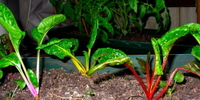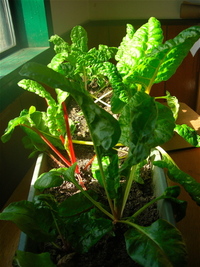As mentioned a few week ago, the tomatoes I brought indoors last autumn haven’t exactly thrived. They are still, by most definitions, alive, but the aphid population is doing better than the tomatoes.
The chard, however, is thriving. At the end of fall I crowded six or seven tiny plants into a two-foot long planter and gave them the best spot I could. The room is unheated, but the window is sunny, so temperatures in winter range from sixty odd by day to thirties at night. The plants haven’t burgeoned, but they’ve grown, and seem happy. The left-hand photo was taken December 18th; that on the right twelve weeks later, on March 9th.
Chard is a cold-weather crop, better suited than tomatoes to conditions in this cold-weather climate and this cold house. It’s also a lot less vulnerable to infestation and disease than tomatoes. The main problem I’ve had with chard here in Montana has been the same I’ve had with spinach and broccoli: leaf-miners, and those I seem not to have imported along with the plants.
There was a slight setback when one of our cats got locked into the room with the chard and uprooted half of it in a desperate search for a cat toilet, but most of the plants seem to have made an excellent recovery from that unfortunate event.
I love these multi-colored stems; they make traditional white chard seem washed-out, bleached, in comparison. When I brought in a fistful of red-stemmed chard one summer a year or so back, my mother thought they were beet greens.
Next year, I’m going to bring in larger plants, and more of them. Next year I won’t let the cat uproot them. Next year…
For the moment, though, I have chard for miso soup, and for omlettes. It’s as tender as spinach, the stems crisp as celery, but prettier.

 Subscribe to RSS feed
Subscribe to RSS feed


